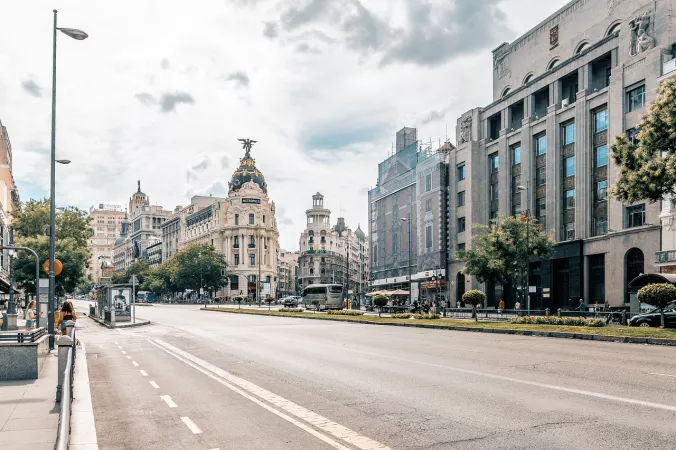
Madrid Travel Guide
Madrid, the vibrant capital of Spain, is a city steeped in history, culture, and artistic heritage. Known for its bustling nightlife, world-class museums, and stunning architecture, Madrid is a popular destination for travelers from around the globe. The city's rich history can be seen in its historic neighborhoods, royal palaces, and ancient landmarks, making it a must-visit for history buffs and culture enthusiasts alike.Top Attractions in Madrid
- Prado Museum
- Royal Palace of Madrid
- Retiro Park
- Plaza Mayor
- Puerta del Sol
Madrid is Famous for
Madrid is famous for its vibrant culture, lively street life, and world-renowned art scene.Top Attractions in Madrid
- Exploring the art at the Prado Museum
- Strolling through the beautiful Retiro Park
- Admiring the stunning architecture of the Royal Palace
- Indulging in delicious tapas at local markets
- Experiencing the lively atmosphere of Plaza Mayor
What's Great about Travelling to Madrid?
- Rich cultural heritage
- Exciting nightlife
- Delicious cuisine
- Beautiful architecture
- Warm and welcoming locals
What's Not So Great about Travelling to Madrid?
- Hot summers can be uncomfortable for some travelers
- Crowded tourist areas
- Language barrier for non-Spanish speakers
- Some areas can be expensive
- Pickpocketing is a concern in tourist areas
Travel Tips for Madrid
- Carry a copy of your passport at all times
- Use public transportation to get around the city
- Try local dishes like paella and churros
- Stay aware of your belongings in crowded areas
- Learn some basic Spanish phrases for easier communication
Important Madrid trip information
- Ideal Duration: A week to fully explore the city
- Best Time to Visit: Spring and fall for pleasant weather
- Nearby Airports and Railway Stations: Adolfo Suárez Madrid–Barajas Airport and Atocha Railway Station
Top 11 Places to visit in Madrid
Per Person
2,52,000
*EXCLUDING APPLICABLE TAXES 5.0 Ratings
( 24 Reviews )
( 24 Reviews )
Per Person
2,04,500
*EXCLUDING APPLICABLE TAXES 5.0 Ratings
( 24 Reviews )
( 24 Reviews )
Per Person
1,62,900
*EXCLUDING APPLICABLE TAXES 5.0 Ratings
( 24 Reviews )
( 24 Reviews )
Per Person
1,95,500
*EXCLUDING APPLICABLE TAXES 5.0 Ratings
( 24 Reviews )
( 24 Reviews )
Per Person
1,75,750
*EXCLUDING APPLICABLE TAXES 5.0 Ratings
( 24 Reviews )
( 24 Reviews )
Total
3,14,000
*EXCLUDING APPLICABLE TAXES 5.0 Ratings
( 24 Reviews )
( 24 Reviews )
FAQ's on Madrid
Q1: What is the best time to visit Madrid?
The best time to visit Madrid is during the spring (March to May) and fall (September to November) when the weather is pleasant, and there are various cultural events happening. Summers can be hot, while winters are mild but can be rainy. Tourist seasons peak during the spring and fall, so plan your trip accordingly to avoid crowds and enjoy the city's offerings.
Q2: Do I need a visa to travel to Madrid?
Most visitors from the USA, Canada, Australia, and the EU do not need a visa to enter Spain for stays up to 90 days. However, it's essential to check the specific visa requirements based on your nationality and the purpose of your visit. Make sure your passport is valid for at least six months beyond your intended stay.
Q3: What are the must-visit attractions in Madrid?
Madrid is home to iconic attractions like the Royal Palace, Prado Museum, Retiro Park, Plaza Mayor, and Puerta del Sol. Don't miss exploring the vibrant neighborhoods of Malasaña, Chueca, and La Latina, known for their lively atmosphere and great food. Enjoy a traditional flamenco show and indulge in delicious tapas at local bars.
Q4: Is Madrid a safe place to travel?
Madrid is generally a safe city for travelers. Like any major city, be cautious of pickpocketing in crowded tourist areas and keep an eye on your belongings. Avoid poorly lit areas at night and be aware of your surroundings. Emergency services are available, and the local police are helpful to tourists.
Q5: What is the local currency in Madrid and can I use credit cards?
The local currency in Madrid is the Euro (€). ATMs are widely available throughout the city, and credit cards are accepted in most establishments, especially in tourist areas. It's advisable to carry some cash for smaller purchases and in case you visit places that might not accept cards.
Q6: What is the local cuisine like in Madrid?
Madrid offers a diverse culinary scene with traditional dishes like "cocido madrileño" (a hearty chickpea-based stew), "bocadillo de calamares" (fried squid sandwich), and "churros con chocolate" (fried dough served with hot chocolate). Don't miss dining at local markets like Mercado de San Miguel for a taste of authentic Spanish flavors.
Q7: What transportation options are available in Madrid?
Madrid has an extensive public transportation system, including metro, buses, and trains, making it easy to navigate the city. Taxis are also readily available, or you can opt for ride-sharing services. Renting a bike is a great way to explore the city at your own pace, especially in areas like Retiro Park.
Q8: Are there any cultural norms or etiquette I should be aware of when visiting Madrid?
When visiting Madrid, it's important to greet people with a handshake or two kisses on the cheeks, depending on the familiarity of the relationship. Respect the local dining customs, such as eating dinner late in the evening. Dress modestly when visiting religious sites and always say "por favor" (please) and "gracias" (thank you) to show politeness. Also, keep in mind that smoking is restricted in many public areas.
Q9: I am a travel agent. How can I buy travel leads of Madrid?
Register yourself as a travel agent at agents.tripclap.com and then you can buy travel leads to Madrid once your account is approved. For more details contact our support team at +91-8069186564 or support@tripclap.com




